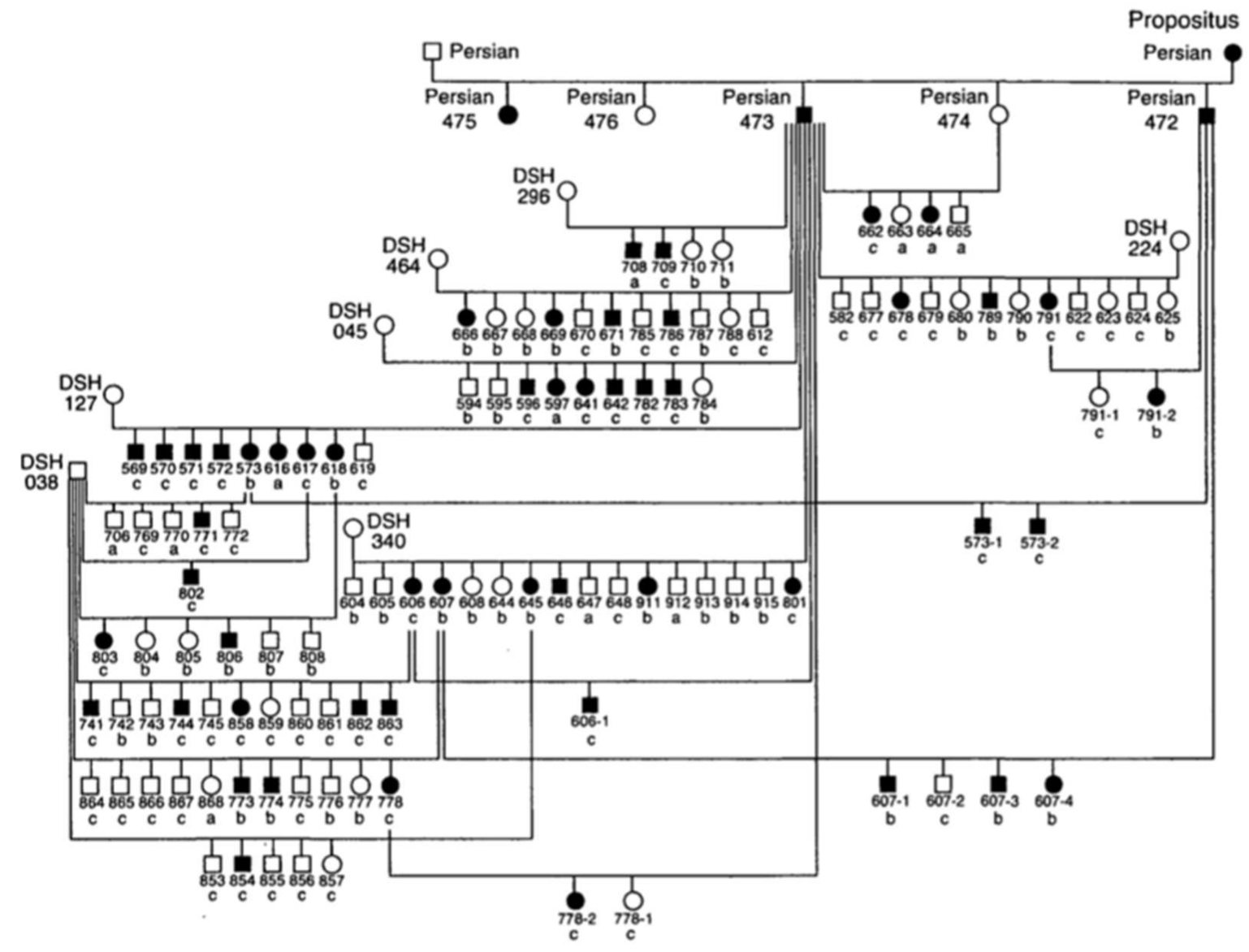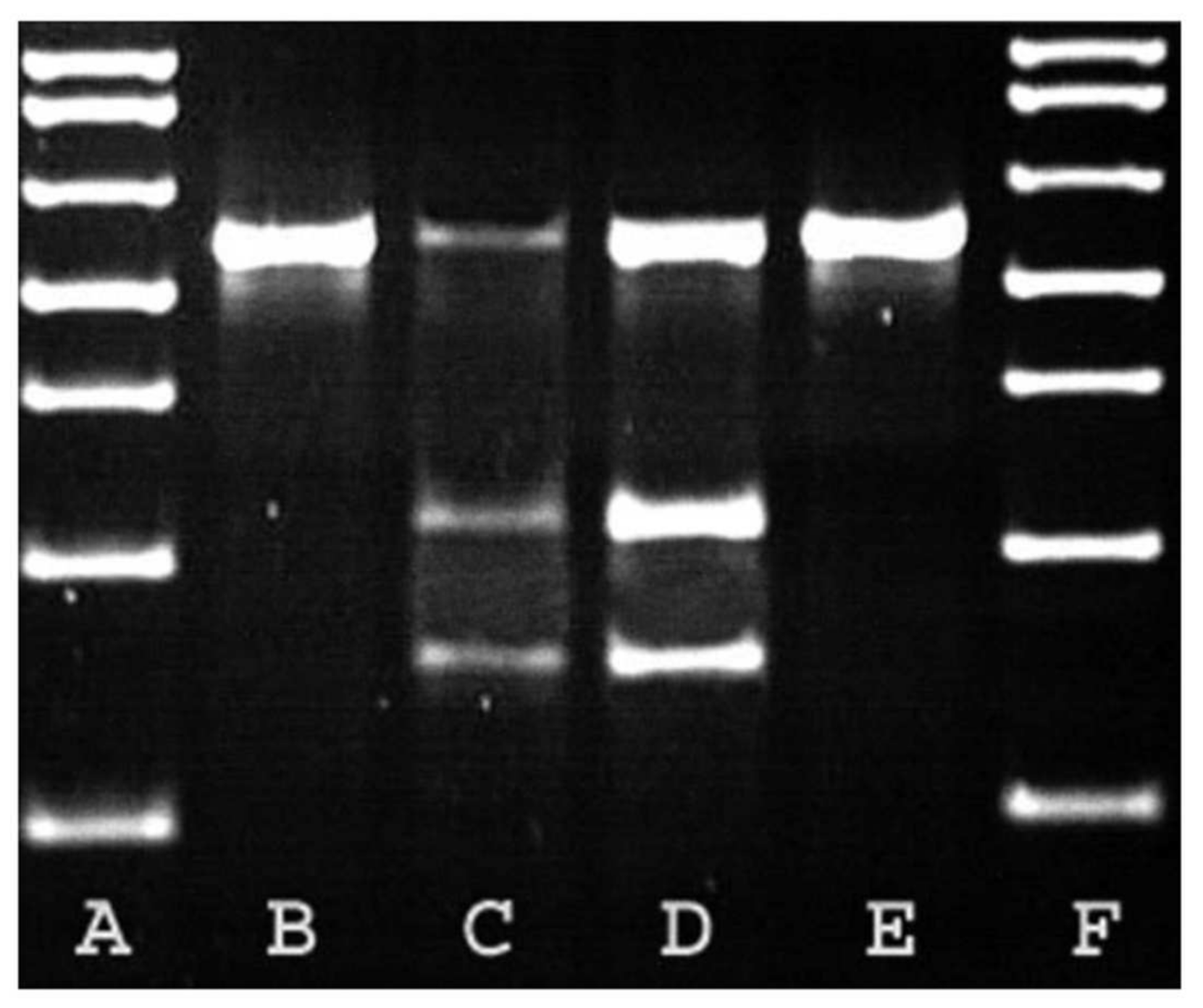Feline Polycystic Kidney Disease: An Update
Abstract
:1. Introduction
2. Epidemiology of Feline PKD
3. Genetic Aspects of Feline PKD
3.1. Gene and Mutation Involved in PKD and Their Identification
3.2. New Perspectives in Genetic Cause of Feline PKD
4. Pathophysiology and Clinical Features
5. Diagnosis of Feline PKD
5.1. Imaging Diagnostic
5.2. Genetic and Molecular Diagnosis
6. Conclusions
Author Contributions
Funding
Institutional Review Board Statement
Informed Consent Statement
Data Availability Statement
Acknowledgments
Conflicts of Interest
References
- Bosje, J.T.; van den Ingh, T.S.; van der Linde-Sipman, J.S. Polycystic Kidney and Liver Disease in Cats. Vet. Q. 1998, 20, 136–139. [Google Scholar] [CrossRef] [PubMed]
- Kimberling, W.J.; Pieke-Dahl, S.A.; Kumar, S. The Genetics of Cystic Diseases of the Kidney. Semin. Nephrol. 1991, 11, 596–606. [Google Scholar]
- Gendron, K.; Owczarek-Lipska, M.; Lang, J.; Leeb, T. Maine Coon Renal Screening: Ultrasonographical Characterisation and Preliminary Genetic Analysis for Common Genes in Cats with Renal Cysts. J. Feline Med. Surg. 2013, 15, 1079–1085. [Google Scholar] [CrossRef]
- Lee, Y.-J.; Chen, H.-Y.; Hsu, W.-L.; Ou, C.-M.; Wong, M.-L. Diagnosis of Feline Polycystic Kidney Disease by a Combination of Ultrasonographic Examination and PKD1 Gene Analysis. Vet. Rec. 2010, 167, 614–618. [Google Scholar] [CrossRef]
- Lyons, L.A.; Biller, D.S.; Erdman, C.A.; Lipinski, M.J.; Young, A.E.; Roe, B.A.; Qin, B.; Grahn, R.A. Feline Polycystic Kidney Disease Mutation Identified in PKD1. J. Am. Soc. Nephrol. 2004, 15, 2548–2555. [Google Scholar] [CrossRef] [PubMed] [Green Version]
- Cannon, M.J.; MacKay, A.D.; Barr, F.J.; Rudorf, H.; Bradley, K.J.; Gruffydd-Jones, T.J. Prevalence of Polycystic Kidney Disease in Persian Cats in the United Kingdom. Vet. Rec. 2001, 149, 409–411. [Google Scholar] [CrossRef]
- Eaton, K.A.; Biller, D.S.; DiBartola, S.P.; Radin, M.J.; Wellman, M.L. Autosomal Dominant Polycystic Kidney Disease in Persian and Persian-Cross Cats. Vet. Pathol. 1997, 34, 117–126. [Google Scholar] [CrossRef]
- Helps, C.; Tasker, S.; Harley, R. Correlation of the Feline PKD1 Genetic Mutation with Cases of PKD Diagnosed by Pathological Examination. Exp. Mol. Pathol. 2007, 83, 264–268. [Google Scholar] [CrossRef]
- Jasik, A.; Kulesza, M. Polycystic Kidney Disease in a Neva Masquerade Cat. J. Small Anim. Pract. 2014, 55, 387. [Google Scholar] [CrossRef] [PubMed]
- Volta, A.; Manfredi, S.; Gnudi, G.; Gelati, A.; Bertoni, G. Polycystic Kidney Disease in a Chartreux Cat. J. Feline Med. Surg. 2010, 12, 138–140. [Google Scholar] [CrossRef] [PubMed]
- Cooper, B.K.; Piveral, P. Autosomal Dominant Polycystic Kidney Disease in Persian Cats. Feline Pract. 2000, 28, 20–21. [Google Scholar]
- Bonazzi, M.; Volta, A.; Gnudi, G.; Bottarelli, E.; Gazzola, M.; Bertoni, G. Prevalence of the Polycystic Kidney Disease and Renal and Urinary Bladder Ultrasonographic Abnormalities in Persian and Exotic Shorthair Cats in Italy. J Feline Med. Surg. 2007, 9, 387–391. [Google Scholar] [CrossRef]
- Lee, Y.-J.; Chen, H.-Y.; Wong, M.-L.; Hsu, W.-L. Molecular Detection of Autosomal-Dominant Feline Polycystic Kidney Disease by Multiplex Amplification Refractory Mutation System Polymerase Chain Reaction. J. Vet. Diagn Investig. 2010, 22, 424–428. [Google Scholar] [CrossRef] [Green Version]
- Barthez, P.Y.; Rivier, P.; Begon, D. Prevalence of Polycystic Kidney Disease in Persian and Persian Related Cats in France. J. Feline Med. Surg. 2003, 5, 345–347. [Google Scholar] [CrossRef]
- Beck, C.; Lavelle, R.B. Feline Polycystic Kidney Disease in Persian and Other Cats: A Prospective Study Using Ultrasonography. Aust. Vet. J. 2001, 79, 181–184. [Google Scholar] [CrossRef]
- Domanjko-Petric, A.; Cernec, D.; Cotman, M. Polycystic Kidney Disease: A Review and Occurrence in Slovenia with Comparison between Ultrasound and Genetic Testing. J. Feline Med. Surg. 2008, 10, 115–119. [Google Scholar] [CrossRef] [PubMed]
- Noori, Z.; Moosavian, H.R.; Esmaeilzadeh, H.; Vali, Y.; Fazli, M. Prevalence of Polycystic Kidney Disease in Persian and Persian Related-Cats Referred to Small Animal Hospital, University of Tehran, Iran. Iran. J. Vet. Res. 2019, 20, 151–154. [Google Scholar] [PubMed]
- Sato, R.; Uchida, N.; Kawana, Y.; Tozuka, M.; Kobayashi, S.; Hanyu, N.; Konno, Y.; Iguchi, A.; Yamasaki, Y.; Kuramochi, K.; et al. Epidemiological Evaluation of Cats Associated with Feline Polycystic Kidney Disease Caused by the Feline PKD1 Genetic Mutation in Japan. J. Vet. Med. Sci. 2019, 81, 1006–1011. [Google Scholar] [CrossRef] [Green Version]
- Guerra, J.M.; Cardoso, N.C.; Daniel, A.G.T.; Onuchic, L.F.; Cogliati, B. Prevalence of Autosomal Dominant Polycystic Kidney Disease in Persian and Persian-Related Cats in Brazil. Braz. J. Biol. 2021, 81, 392–397. [Google Scholar] [CrossRef] [PubMed]
- Barrs, V.R.; Gunew, M.; Foster, S.F.; Beatty, J.A.; Malik, R. Prevalence of Autosomal Dominant Polycystic Kidney Disease in Persian Cats and Related-Breeds in Sydney and Brisbane. Aust. Vet. J. 2001, 79, 257–259. [Google Scholar] [CrossRef] [PubMed]
- Rodney, A.R.; Buckley, R.M.; Fulton, R.S.; Fronick, C.; Richmond, T.; Helps, C.R.; Pantke, P.; Trent, D.J.; Vernau, K.M.; Munday, J.S.; et al. A Domestic Cat Whole Exome Sequencing Resource for Trait Discovery. Sci. Rep. 2021, 11, 7159. [Google Scholar] [CrossRef] [PubMed]
- Scalon, M.C.; da Silva, T.F.; Aquino, L.C.; Carneiro, F.T.; Lima, M.G.d.M.; Lemos, M.D.S.; Paludo, G.R. Touchdown Polymerase Chain Reaction Detection of Polycystic Kidney Disease and Laboratory Findings in Different Cat Populations. J. Vet. Diagn Investig. 2014, 26, 542–546. [Google Scholar] [CrossRef] [Green Version]
- Polycystic Kidney Disease (PKD): Gene Test and Negative Register | International Cat Care. Available online: https://icatcare.org/advice/polycystic-kidney-disease-pkd-gene-test-and-negative-register/ (accessed on 11 August 2021).
- Biller, D.S.; Chew, D.J.; DiBartola, S.P. Polycystic Kidney Disease in a Family of Persian Cats. J. Am. Vet. Med. Assoc. 1990, 196, 1288–1290. [Google Scholar]
- Biller, D.S.; DiBartola, S.P.; Eaton, K.A.; Pflueger, S.; Wellman, M.L.; Radin, M.J. Inheritance of Polycystic Kidney Disease in Persian Cats. J. Hered 1996, 87, 1–5. [Google Scholar] [CrossRef] [Green Version]
- Battershell, D.; Garcia, J.P. Polycystic Kidney in a Cat. J. Am. Vet. Med. Assoc. 1969, 154, 665–666. [Google Scholar] [PubMed]
- Young, A.E.; Biller, D.S.; Herrgesell, E.J.; Roberts, H.R.; Lyons, L.A. Feline Polycystic Kidney Disease Is Linked to the PKD1 Region. Mamm. Genome 2005, 16, 59–65. [Google Scholar] [CrossRef] [PubMed]
- Al-Bhalal, L.; Akhtar, M. Molecular Basis of Autosomal Recessive Polycystic Kidney Disease (ARPKD). Adv. Anat. Pathol. 2008, 15, 54–58. [Google Scholar] [CrossRef] [PubMed]
- Bear, J.C.; Parfrey, P.S.; Morgan, J.M.; Martin, C.J.; Cramer, B.C. Autosomal Dominant Polycystic Kidney Disease: New Information for Genetic Counselling. Am. J. Med. Genet. 1992, 43, 548–553. [Google Scholar] [CrossRef] [PubMed]
- Crowell, W.A.; Hubbell, J.J.; Riley, J.C. Polycystic Renal Disease in Related Cats. J. Am. Vet. Med. Assoc. 1979, 175, 286–288. [Google Scholar]
- Wicher, D.; Obrycki, Ł.; Jankowska, I. Autosomal Recessive Polycystic Kidney Disease-The Clinical Aspects and Diagnostic Challenges. J. Pediatr. Genet. 2021, 10, 1–8. [Google Scholar] [CrossRef]
- Kimberling, W.J.; Kumar, S.; Gabow, P.A.; Kenyon, J.B.; Connolly, C.J.; Somlo, S. Autosomal Dominant Polycystic Kidney Disease: Localization of the Second Gene to Chromosome 4q13-Q23. Genomics 1993, 18, 467–472. [Google Scholar] [CrossRef]
- Gluecksmann-Kuis, M.A.; Tayber, O.; Woolf, E.A.; Bougueleret, L.; Deng, N.H.; Alperin, G.D.; Iris, F.; Hawkins, F.; Munro, C.; Lakey, N.; et al. Polycystic Kidney Disease: The Complete Structure of the PKD1 Gene and Its Protein. Cell 1995, 81, 289–298. [Google Scholar] [CrossRef] [Green Version]
- Peters, D.J.; Spruit, L.; Saris, J.J.; Ravine, D.; Sandkuijl, L.A.; Fossdal, R.; Boersma, J.; van Eijk, R.; Nørby, S.; Constantinou-Deltas, C.D. Chromosome 4 Localization of a Second Gene for Autosomal Dominant Polycystic Kidney Disease. Nat. Genet. 1993, 5, 359–362. [Google Scholar] [CrossRef]
- Liu, S.; Lu, W.; Obara, T.; Kuida, S.; Lehoczky, J.; Dewar, K.; Drummond, I.A.; Beier, D.R. A Defect in a Novel Nek-Family Kinase Causes Cystic Kidney Disease in the Mouse and in Zebrafish. Development 2002, 129, 5839–5846. [Google Scholar] [CrossRef] [PubMed] [Green Version]
- Yu, Y.; Shumway, K.L.; Matheson, J.S.; Edwards, M.E.; Kline, T.L.; Lyons, L.A. Kidney and Cystic Volume Imaging for Disease Presentation and Progression in the Cat Autosomal Dominant Polycystic Kidney Disease Large Animal Model. BMC Nephrol. 2019, 20, 259. [Google Scholar] [CrossRef] [Green Version]
- Cornec-Le Gall, E.; Olson, R.J.; Besse, W.; Heyer, C.M.; Gainullin, V.G.; Smith, J.M.; Audrézet, M.-P.; Hopp, K.; Porath, B.; Shi, B.; et al. Monoallelic Mutations to DNAJB11 Cause Atypical Autosomal-Dominant Polycystic Kidney Disease. Am. J. Hum. Genet. 2018, 102, 832–844. [Google Scholar] [CrossRef] [Green Version]
- Guerra, J.M.; Daniel, A.G.T.; Cardoso, N.C.; Grandi, F.; Queiroga, F.; Cogliati, B. Congenital Hepatic Fibrosis and Polycystic Kidney Disease Not Linked to C >A Mutation in Exon 29 of PKD1 in a Persian Cat. JFMS Open Rep. 2015, 1, 2055116915619191. [Google Scholar] [CrossRef] [PubMed] [Green Version]
- Lu, H.; Galeano, M.C.R.; Ott, E.; Kaeslin, G.; Kausalya, P.J.; Kramer, C.; Ortiz-Brüchle, N.; Hilger, N.; Metzis, V.; Hiersche, M.; et al. Mutations in DZIP1L, Which Encodes a Ciliary-Transition-Zone Protein, Cause Autosomal Recessive Polycystic Kidney Disease. Nat. Genet. 2017, 49, 1025–1034. [Google Scholar] [CrossRef]
- Chebib, F.T.; Torres, V.E. Autosomal Dominant Polycystic Kidney Disease: Core Curriculum 2016. Am. J. Kidney Dis. 2016, 67, 792–810. [Google Scholar] [CrossRef] [PubMed] [Green Version]
- Bilgen, N.; Bişkin Türkmen, M.; Çınar Kul, B.; Isparta, S.; Şen, Y.; Akkurt, M.Y.; Çıldır, Ö.Ş.; Bars, Z. Prevalence of PKD1 Gene Mutation in Cats in Turkey and Pathogenesis of Feline Polycystic Kidney Disease. J. Vet. Diagn Investig. 2020, 32, 549–555. [Google Scholar] [CrossRef]
- Braun, W.E. Autosomal Dominant Polycystic Kidney Disease: Emerging Concepts of Pathogenesis and New Treatments. Cleve. Clin. J. Med. 2009, 76, 97–104. [Google Scholar] [CrossRef] [Green Version]
- Noël, N.; Rieu, P. [Pathophysiology, epidemiology, clinical presentation, diagnosis and treatment options for autosomal dominant polycystic kidney disease]. Nephrol. Ther. 2015, 11, 213–225. [Google Scholar] [CrossRef]
- Frazier, R.L.; Huppmann, A.R. Educational Case: Autosomal Dominant Polycystic Kidney Disease. Acad. Pathol. 2020, 7, 2374289520939257. [Google Scholar] [CrossRef]
- Sharma, M.; Reif, G.A.; Wallace, D.P. In Vitro Cyst Formation of ADPKD Cells. Methods Cell Biol. 2019, 153, 93–111. [Google Scholar] [CrossRef] [PubMed]
- Bergmann, C. ARPKD and Early Manifestations of ADPKD: The Original Polycystic Kidney Disease and Phenocopies. Pediatr. Nephrol. 2015, 30, 15–30. [Google Scholar] [CrossRef] [PubMed] [Green Version]
- Guerra, J.M.; Freitas, M.F.; Daniel, A.G.; Pellegrino, A.; Cardoso, N.C.; de Castro, I.; Onuchic, L.F.; Cogliati, B. Age-Based Ultrasonographic Criteria for Diagnosis of Autosomal Dominant Polycystic Kidney Disease in Persian Cats. J. Feline Med. Surg. 2019, 21, 156–164. [Google Scholar] [CrossRef] [PubMed]
- Harris, P.C.; Bae, K.T.; Rossetti, S.; Torres, V.E.; Grantham, J.J.; Chapman, A.B.; Guay-Woodford, L.M.; King, B.F.; Wetzel, L.H.; Baumgarten, D.A.; et al. Cyst Number but Not the Rate of Cystic Growth Is Associated with the Mutated Gene in Autosomal Dominant Polycystic Kidney Disease. J. Am. Soc. Nephrol. 2006, 17, 3013–3019. [Google Scholar] [CrossRef] [PubMed] [Green Version]
- Nivy, R.; Lyons, L.A.; Aroch, I.; Segev, G. Polycystic Kidney Disease in Four British Shorthair Cats with Successful Treatment of Bacterial Cyst Infection. J. Small Anim. Pract. 2015, 56, 585–589. [Google Scholar] [CrossRef]
- McConnachie, D.J.; Stow, J.L.; Mallett, A.J. Ciliopathies and the Kidney: A Review. Am. J. Kidney Dis. 2021, 77, 410–419. [Google Scholar] [CrossRef] [PubMed]
- Bonazzi, M.; Volta, A.; Gnudi, G.; Cozzi, M.C.; Strillacci, M.G.; Polli, M.; Longeri, M.; Manfredi, S.; Bertoni, G. Comparison between Ultrasound and Genetic Testing for the Early Diagnosis of Polycystic Kidney Disease in Persian and Exotic Shorthair Cats. J. Feline Med. Surg. 2009, 11, 430–434. [Google Scholar] [CrossRef]


| Age (Months) | Diagnostic Criteria for Kidney Ultrasound |
|---|---|
| ≤15 | ≥1 cyst |
| 16–32 | ≥2 cysts |
| 33–49 | ≥3 cysts |
| 50–66 | ≥4 cysts |
Publisher’s Note: MDPI stays neutral with regard to jurisdictional claims in published maps and institutional affiliations. |
© 2021 by the authors. Licensee MDPI, Basel, Switzerland. This article is an open access article distributed under the terms and conditions of the Creative Commons Attribution (CC BY) license (https://creativecommons.org/licenses/by/4.0/).
Share and Cite
Schirrer, L.; Marín-García, P.J.; Llobat, L. Feline Polycystic Kidney Disease: An Update. Vet. Sci. 2021, 8, 269. https://doi.org/10.3390/vetsci8110269
Schirrer L, Marín-García PJ, Llobat L. Feline Polycystic Kidney Disease: An Update. Veterinary Sciences. 2021; 8(11):269. https://doi.org/10.3390/vetsci8110269
Chicago/Turabian StyleSchirrer, Lorie, Pablo Jesús Marín-García, and Lola Llobat. 2021. "Feline Polycystic Kidney Disease: An Update" Veterinary Sciences 8, no. 11: 269. https://doi.org/10.3390/vetsci8110269
APA StyleSchirrer, L., Marín-García, P. J., & Llobat, L. (2021). Feline Polycystic Kidney Disease: An Update. Veterinary Sciences, 8(11), 269. https://doi.org/10.3390/vetsci8110269







